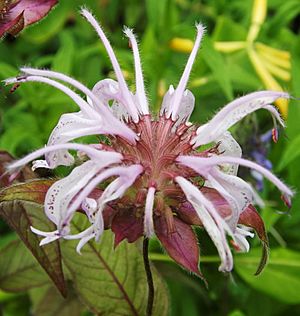Eastern beebalm facts for kids
Monarda bradburiana, also known as the eastern beebalm or Bradbury's beebalm, is a beautiful flowering plant. It belongs to the mint family, called Lamiaceae. This plant grows naturally in many parts of the southeastern United States. It's a type of plant that comes back year after year.
Quick facts for kids Eastern beebalm |
|
|---|---|
 |
|
| Scientific classification | |
| Genus: |
Monarda
|
| Species: |
bradburiana
|
Contents
What Does It Look Like?
Monarda bradburiana is a plant that grows back every year. It can reach a height of about 30 to 60 centimeters (1 to 2 feet). Its stems are mostly straight and have a square shape. They usually don't have many branches. The stems are often smooth, but new parts might have a few hairs.
The leaves grow in pairs directly across from each other. They are about 9 centimeters (3.5 inches) long and 5 centimeters (2 inches) wide. They are shaped like an oval or a wide spear. The edges of the leaves have small teeth. Lower leaves have short stems called petioles. The leaves higher up grow close to the main stem. The top of the leaves can be a bit fuzzy. They are usually yellowish-green or green. Sometimes, they have purple spots or edges. The leaves at the very top act like special leaves called bracts. These bracts sit just below the flowers.
The Flowers
The flowerheads are about 4 centimeters (1.5 inches) wide. When they first appear, they look like cones. Later, they flatten out. The flowers in the center open first. Each tiny flower has a cup-like part called a calyx. This calyx is shaped like a tube and is a bit hairy. It has five pointed tips.
The actual flowers are white or pink. They are curved and about 2.5 centimeters (1 inch) long. Each flower has a narrow tube and an upper lip. It also has a slightly wider lower lip. This lower lip often has purple speckles. These flowers usually bloom in late spring and early summer. After blooming, the plant produces small seeds called nutlets. The wind can carry these seeds to new places. The plant can also spread by growing new shoots from underground stems called rhizomes.
Where Does It Grow?
Monarda bradburiana is native to the central and southeastern parts of the United States. You can find it in many states. These include Alabama, Arizona, Iowa, Illinois, Indiana, Kansas, Kentucky, Louisiana, Missouri, Oklahoma, Tennessee, and Texas.
This plant likes to grow in certain places. You might see it in thickets, which are dense groups of bushes. It also grows at the edges of woodlands. It can be found in grasslands and along roadsides too.
Who Visits This Plant?
The flowers of Monarda bradburiana make a lot of sweet liquid called nectar. This nectar attracts many different creatures.
Pollinators
- Bumblebees and other long-tongued bees love the nectar.
- Butterflies also visit the flowers.
- Hummingbird moths are another visitor.
- Beeflies and hummingbirds come for the nectar too.
Some bees, like halictid bees, collect pollen from the flowers. They cannot reach the nectar. There is even a special bee called Doufourea monardae. This small black bee is a specialist pollinator for this plant.
Other Visitors
This plant is a food source for several types of caterpillars. These include:
- The hermit sphinx caterpillar
- The gray marvel caterpillar
- The orange mint moth caterpillar
- The raspberry pyrausta moth caterpillar
Interestingly, plant-eating mammals usually stay away from the leaves. This might be because the plant smells a bit like oregano.

